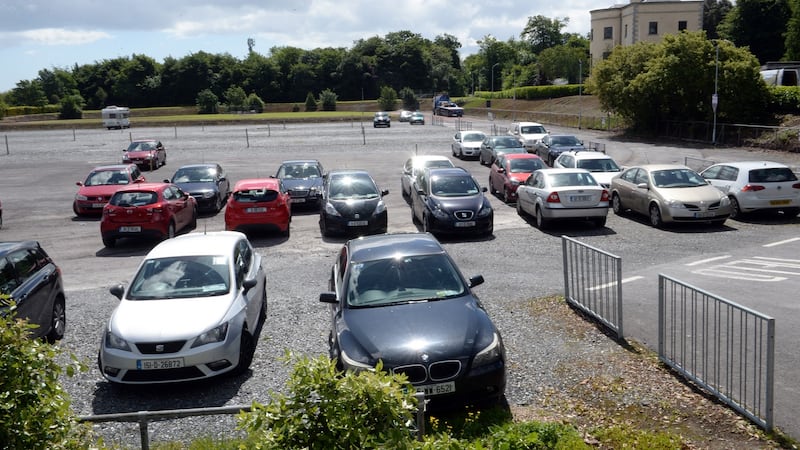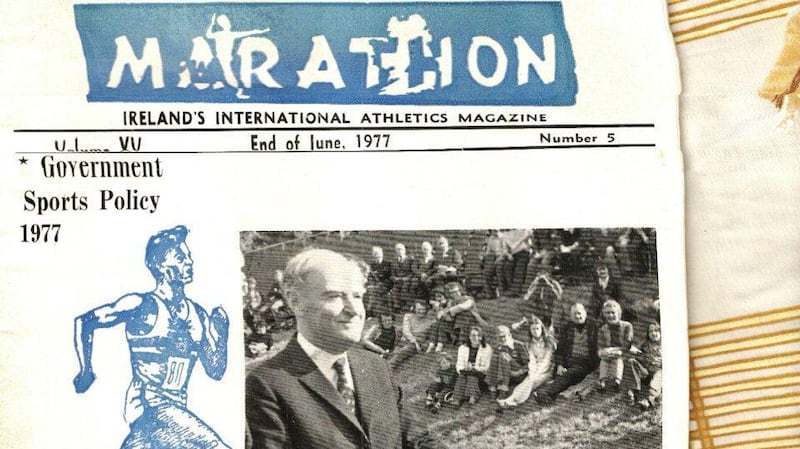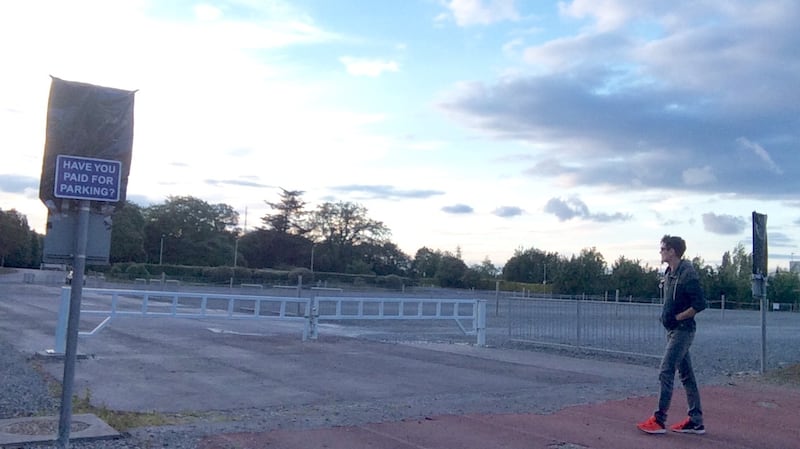There are few more sad and lonely sights than the abandoned sporting arena, and 40 years ago this week, when then taoiseach Liam Cosgrave officially opened the new athletics track at Belfield, could anyone have imagined it would end up in this state?
Or indeed that Cosgrave himself would outlive it?
It had been publicly financed by a hefty 175,000 of our dear old punts, only for anyone in the 6,000 attendance on the banks of the track that Tuesday evening, June 14th 1977, cost was no issue.
This was the first tartan running track in the Republic (the Mary Peters track in Belfast had opened on Easter Monday, 1976), and complete with electronic timing and a photo-finish, it was our modern sporting venue par excellence.
University College Dublin (UCD) was chosen given both its convenience of location and suitability for the track itself, including its peaceful surrounds and potential for maximum use considering the fast-increasing student body on the Belfield campus.

Today that same track lies half dismembered and still partly decomposed, as if lying in its own shallow and unkempt grave.
Although not entirely quiet, by day, half of that once world record arena serves as a busy car park and the choking engine fumes that come with it. By evening, it rests as a lonesome monument to itself, especially on these long, bright June evenings when it was once filled with athletes running and jumping and dreaming out loud.
The rise and subsequent fall of the Belfield track has already been told, initially greeted with the shock and horror of a sudden amputation, not the silent realisation of an old sporting facility that had perhaps run its course – the still saddest part being that six years after being partly torn up, and three years after being partly relaid as a stony car park, UCD is no closer to providing a replacement.
What everyone with even a passing interest in Irish athletics agrees on is the absurdity of the largest student body in Ireland, some 32,000 and counting, not having access to a running track.
What there is less agreement on is why the track was dug up in the first place, and some athletes, especially those within UCD, are becoming more outspoken on the issue, believing it should never have been six years ago to begin with.
“I think it’s something that is terribly missed, and being the largest student university in Ireland, it’s a disgrace that we don’t have a track on campus, and that they tore it up without replacing it,” says Ciara Mageean, the Rio 2016 Olympian who took up an athletics’ scholarship in UCD in 2011, just weeks before the track was first decommissioned.
Touchy subject
“Imagine they did that with the GAA pitches? Said we’ll build you another one in a few years time? I know the track wasn’t in the best shape, but it was still 400m around, and if you were in a decent pair of flats, it was fine. So I just don’t think they should have torn up the track until there was firm foundation for another one. That should never have happened. So it’s definitely a bit of a raw and touchy subject, for me.”
James Nolan, who ran for Ireland in the 1,500m at both the Sydney 2000 Olympics and Athens 2004, while representing UCD Athletics Club, shares her emotions, and can also delve into the track’s emotional past.

Nolan started in UCD when athletics there was still under the guidance of the late Noel Carroll, who he describes as “like a second a father to me and to many other athletes at UCD”, and for him the idea of not having a track on campus is equally absurd.
Part of Nolan’s coaching role today is back at his alma mater, as athletics co-ordinator for UCD, and like Mageean, he saw the track not just as an ordinary athletics facility but an important way of facilitating athletics at UCD.
“It was more about having a home for UCD athletics,” says Nolan. “And just before the track was dug up, there was a rebirth of UCD athletics. It was getting strong at the both the scholarship and club level, which hadn’t been there since Noel Carroll’s time, and which when I came back in, I tried to replicate.
“You could go to the track at set times, and the sprinters, the throwers, the middle distance runners were all there, all creating a bond, getting to know each other, and fight for each other in competition.
“What happened then was the heart of UCD athletics was ripped out, and the home was gone. We still have high achievers, who are brought in to UCD on scholarship, which is great. But they’re going to succeed anyway, because when you have high achievers, they will travel, do whatever is necessary, to get the session done.”
News of the track’s closure, on November 22nd 2011, was coarsely abrupt: UCD AC was given just 21 hours notice, that “due to health and safety concerns” and given “the surface is badly worn and becomes slippery when wet” the track “should be closed to all users”.
A statement from the UCD student president’s office added: “Works to redress this situation have already commenced and we hope to be able to provide an alternative facility on campus in the future, subject to funding becoming available.”
The track was worn, though not necessarily badly, and the “slippery when wet” sounded particularly dubious.
Unbelievable claim
“‘Slippery when wet’ is an unbelievable claim for which to shut the doors of this facility,” said Antoine Burke at the time, one of UCD’s best athletes in the 1990s. “This attitude seriously undermines the intelligence of the sporting community who’ve valued the UCD track over the years.”
At first, JCBs carved out trenches at very deliberate intervals so render the track useless for any training purposes. For three years it acted as a storage space for steel crates of bricks and other building materials for various construction projects around the campus, and also staged the UCD Ball, in May 2012, around the same time many UCD athletes might have made better use of the track when training for the London Olympics.
Then in June 2014, the JCBs moved back in and turned the entire lower half of the track into a car park; the top half, including the finishing line and once sacred track entrance, lies in ruinous disrepair.
Sacred because from its debut night the track created a hallowed air. Cosgrave, two days before the 1977 General Election he would lose, opened it to some considerable fanfare, including the old flourish of trumpets, and this was followed by an international quadrangular match, the main event being the Roadstone Invitation 3,000m.

Eamonn Coghlan, in one of his first races since finishing fourth in the 1976 Olympics the previous year, stole the show with his victory in 7:50.1, an Irish record, after which he was mobbed by young autograph hunters.
Belfield held its reputation for fast times in the years after, most famously at the GOAL charity meeting on August 17th 1985, when four of Ireland’s top milers, including Coghlan, ran a 4x1-mile relay world record of 15:48.08, which still stands.
“The other thing about the UCD track, and anyone would tell you this, is that it was the best training track around,” says Nolan. “People could warm-up around the fields and grass, there was a lovely vibe to the place, and athletes were always supportive of each other, no matter what club.
“It’s not just about UCD AC. UCD is a hub, with people who run for Ireland, compete for other clubs outside of here. And of the students here, maybe 24,000 are in the age bracket that Athletics Ireland wants to be focusing in on. I’ve looked up the stats, and Galway city only has 9,000-10,000 people within that age bracket, 18-25, and that’s a city. So UCD is a massive city, really, a massive area for athletics which isn’t being tapped into.”
When contacted by The Irish Times, Brian Mullins, director of sport at UCD, declined to comment on any issue concerning the running track at UCD; on further inquiry, a statement from the office of Campus Sports and Leisure said: "UCD remains committed to having an athletics track on campus as part of our overall sporting facilities should the necessary funding become available."
Other sports
Mageean recently completed her physiotherapy degree at UCD and continues to do much of her training on the campus: at 25, and freshly qualified for the 1,500m at the World Championships in London in August, she intends on basing herself at the Dublin campus for the foreseeable future, although her campaigning for a replacement track is far from personal.
During a recent awards event at UCD, she stood up in front of most of the university’s highest ranked officials to highlight the plight. Mageean also sits on a new working group in UCD to bring forward suggestions on the overall working sporting structures within UCD.
“The track is a subject close to my heart”, she says. “There is talk of a replacement, but nothing set in stone as far as I can see. We were told in the athletics club they do have planning permission for a new track down in the Clonskeagh end, I’m not sure if that’s gone by now.
“But I know as well some other sports also find it tough. I’ve been made aware the hockey pitch isn’t really up to playing standard anymore.
“The sheer number of people entering sport in UCD is growing and growing, but the facilities for sport aren’t growing along with it. We do have a fantastic indoor sports facility, but there also needs to be the structure and the network that can bring more students into it.
“It’s definitely been an inconvenience for me, and come any given Saturday we don’t know where we’re going to train. I’m nearly aware of what time every club in Dublin train, because we try to train around them. It could be Ringsend, or Tallaght, or Greystones, and we end up going pillar to post.
“I know other projects do have to take precedence, and understand there are other factors. The big frustration for me is that they tore up the track before having a replacement.”
Despite the lack of a track, UCD still qualified three athletes for Rio: Mageean, plus Mark English and Ciara Everard (both over 800m). That, says Nolan, doesn’t mean they should continue without one.
“Like any athletics man, I would love to see a track here. If that means building a six-lane training track on the original replacement side, with some Astra-turf in the middle, to help pay for itself, I totally understand that. And I know UCD are following the US campus model now, zoning parts of the campus, such as for sport. But I think for the size of the university, and the history and tradition it has in athletics, it needs to have an athletics track.”
Watch the 4x1-mile WR set at Belfield –
https://www.youtube.com/watch?v=IpnFS62KVlM
The rise and fall of the Belfield running track –
June 1977: Having begun its life as a grass running track, before an all-weather cinder surface was laid in 1974, Belfield is officially opened as the first tartan track in the Republic by Taoiseach Liam Cosgrave. Among the highlights of the opening night's meeting is an Irish 3,000m record of 7:50.1 by Eamonn Coghlan.
July 1977: John Walker from New Zealand, reigning Olympic 1,500m champion, wins the Morton Mile in Belfield in 3:52.76, leading eight runners under the four-minute barrier.
July 1978: Steve Ovett from Great Britain, future Olympic 800m champion, wins the Morton Mile in Belfield in 3.55.70.
July 1979: Steve Scott from the USA wins the Morton Mile in Belfield 3.56.26.
July 1980: Belfield, now the home of the Irish National championships, sees John Treacy win the 5,000m in 13:21.9 – a then Irish record, which still stands as the National Championship record.
July 1983: Eamonn Coghlan wins the Morton Mile in Belfield in 3:53.48
December 1983: One year after Noel Carroll had assembled a small group of runners in the Phoenix Park for the first Christmas Day GOAL charity mile, Belfield becomes its spiritual home, and remains so for the next 25 years.
August 1985: At the GOAL charity meeting, the cream of Irish milers of the time target the world record for the 4x1-mile relay, and ended up bettering the time by 10 seconds when clocking 15:49.08, a record that still stands to this day. It also drew one of the largest crowds in Irish athletics history to Belfield, who witnessed the quartet of Eamonn Coghlan (4:00.2), Marcus O'Sullivan (3:55.3), Frank O'Mara (3:56.6) and Ray Flynn (3:56.9) underline their status as the world's best milers of the time.
June 1987: Sonia O'Sullivan is among the hordes of young athletes to sign off her schools athletics career with victory in the 800m.
Throughout the 1990s: The Belfield track is the main training base for UCD athletes including David Matthews, still Irish record holder over 800, James Nolan, two-time Olympian over 1,500m, and Antoine Burke, silver medallist in the high jump in the 1994 World Junior Championships.
April 2011: UCD bid for the university to be considered a pre-London Olympic 2012 training base, Martin Butler, then Vice President for Students, assured funding for a new track was a "key aspect" of the campaign. Nothing materialises.
November 2011: Track is closed after just 21 hours notice, "due to health and safety concerns", a statement adding that: "works to redress this situation have already commenced and we hope to be able to provide an alternative facility on campus in the future, subject to funding becoming available".
June 2014: The lower half of the track site is converted into a car park.
June 2017: The Belfield track continues to operate as a pay-per-use car park, a statement from UCD saying: "UCD remains committed to having an athletics track on campus as part of our overall sporting facilities should the necessary funding become available."



















